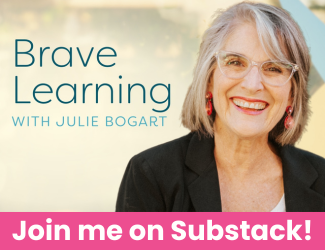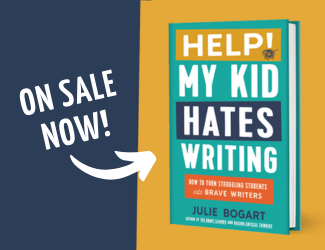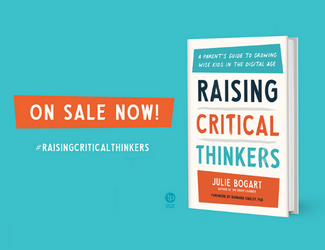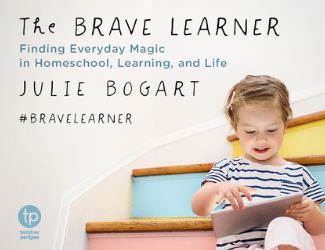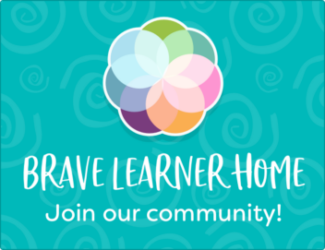Do you believe in luck? Why or why not.
New to freewriting? Check out our online guide.
Do you believe in luck? Why or why not.
New to freewriting? Check out our online guide.
Posted in Friday Freewrite | Comments Off on Friday Freewrite: Lucky
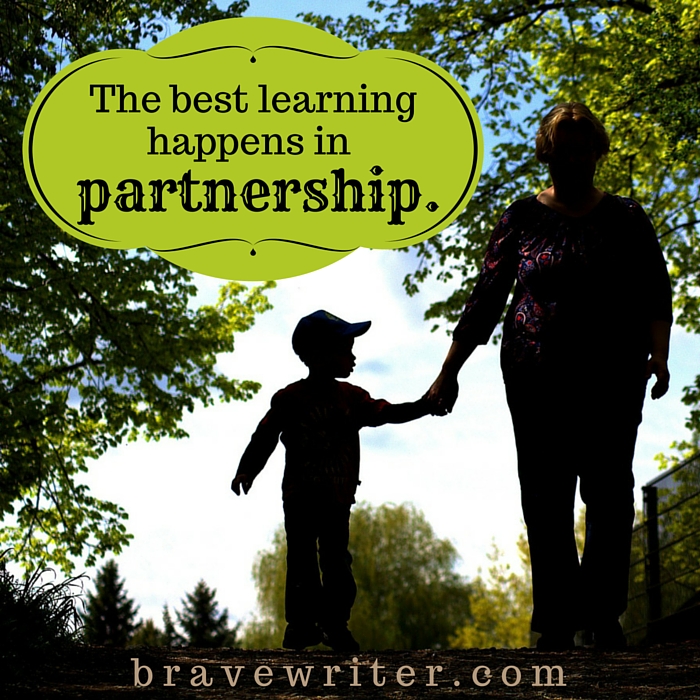
“Child-led learning” is a misnomer, I think. It implies that your child will take the lead in learning. Parents, exhausted from prodding and pushing, hand the reins to their children, relieved that the pressure to “teach” is off. What sometimes follows, however, is a swing from well-ordered (if resisted) structure, to unfettered freedom and aimless wandering through the house.
The insight that “child-led learning” generates is that kids learn best when they are invested—when they care and want to learn. We see the unvarnished version of this experience when our kids play an online game or teach themselves to skip count or watch them train a pet rat to jump up the stairs. We hope that this energy for focused acquisition of skills will translate into the 3 R’s…and worry when we can’t make out if that is, in fact, happening.
Unschooling (particularly its “radical” version) sometimes appears so hands off, parents become paralyzed, unwilling to “interfere” with a child’s self-directed education for fear they are undermining the purity of that educational philosophy.
But even the most seasoned unschoolers will tell you that they are involved in their children’s learning adventures. They start by honoring a child’s natural affinities, by stepping aside and not scripting a child’s daytime activities. But that’s not where it stays. Not at all.
The best learning happens in partnership. That’s true everywhere, in every context. Yes, we can teach ourselves thousands of things without school or teachers or tests. But we all depend on tools and resources to support that learning. We read books written by experts, we go to lectures, we Google and find articles or images, we consult our phone apps, we ask our spouses, we join clubs and committees, we talk with friends over coffee, we post to discussion groups, we take classes, we compare our work to the work of skilled practitioners better at “it” than us, we get advice when we are stuck or need more assistance, we practice and then we perform (whether piano, quilting, or a holiday dinner). We get feedback and let that help us become “better at it” (whatever “it” is).
You are your child’s best resource for learning bar none. You provide a link to learning opportunities your child can’t even know exist. How would a child develop an interest in Middle English without a parent who showed him the original text of The Canterbury Tales? How would a child know about The Canterbury Tales without a parent? How would you know about them without having studied them in college or perhaps reading about them in a classical education home schooling book?
The birds in the backyard may catch a child’s interest without you exclaiming: “Oh, look at the male cardinal!” But will your child know to consult a field guide? Will she have discovered local birding groups, or the National Great Christmas Bird Count on her own?

You are the gateway to all that “child-led learning.” Your curiosity, your love of learning, your money and transportation, your decades of experiences, your connections—your kids need these! When a child shows interest in film, it’s your iPhone she can borrow.
Some interests are passing. Some flower into lifelong passions.
Your job isn’t necessarily to follow your child’s interests around. Sometimes your job is to introduce potential interests to your child, or to live your interests in front of and with your child, and sometimes your job is to enhance the interests your child exhibits! I was never curious about the night sky, but Jacob was. We wound up at the Cincinnati Observatory, we purchased a telescope, and I watched meteor showers on blankets in our backyard in the middle of the night with him. I saw Saturn (the real planet! not just a photo in a book, my friends! it exists!) through a telescope after Jacob lined it up for me. He became the teacher, and I, the student! That moment is one of the highlights of my entire life, let alone homeschool.
We are partners to our children. We are learners. We are teachers. We are drivers, companions, cheerleaders, shoulders-to-cry-on, experts, novices, check-writers, friends, and parents.
Be involved. If your child needs to learn to tie her shoes, sit with her and help her. If she loses interest today, buy clogs. A day will come when she gets the motivation to tie her shoes herself, and she will learn.
You are free to talk to your kids, too, about your concerns for their education. Why not? Why not share: “You know, at some point you may need these times tables. Let’s see what options exist for learning them, and how they relate to all the things you care about. I am interested in your input about how we go about this subject area”? Then be interested. Find a way that works for your child.
Partnership learning is the way forward in home education. It accounts for both needs—the child’s need to get an education he or she values, and the parent’s need to participate in it and direct it to some degree.
Some days (weeks, months) will be that joyful, seamless adventure of following a child’s passion. Other days (weeks, months) will be led by a parent’s vision and enthusiasm, caught by the children.
And some days (weeks, months), you’ll trudge along until you hit one of those golden educational jags led by either of you, again.
Trust the process. Be involved. Pay attention. Care. Share. Dance—your child leads, you follow; you lead, the child follows; you both get cups of lemonade and take a break.
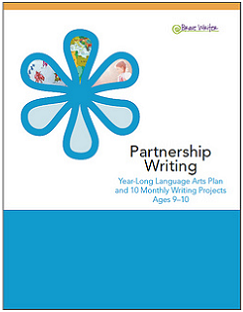 A Year-Long Language Arts Plan!
A Year-Long Language Arts Plan!
9-10 year olds (age range is approximate)
Developmentally appropriate projects.
Step-by-step instructions.
A weekly and monthly plan.
The Writer’s Jungle provides you with the essential tools that enable you to be an effective writing coach. Partnership Writing is the product that gives you a practical routine (think, schedule ala Brave Writer).
Download a FREE SAMPLE on our product page.
Posted in Brave Writer Philosophy, Homeschool Advice | 3 Comments »
Yes, that was a long title. Let’s talk about it for a few minutes.
I hear from moms who feel badly that they are not doing more of X (copywork, dictation, poetry teatimes, lullabies before bed, housekeeping, revising freewrites, science, read alouds, nature study, Shakespeare, field trips, math pages, phonics, creative writing, report writing, history, time alone with one child, games, movies…). You name it; someone feels guilty about not doing enough of it.
When I began to develop products for Brave Writer, I had one thought in mind: How do I help moms feel successful without requiring them to do more than they actually will?
In other words: how can I help them to succeed? In reality?
Many programs promise the illusion of success (follow these five steps, keep this 36 week schedule, order your days around this daily lesson). Then you get two weeks in, life happens, and the plan goes out the window.
What follows is this: the big “give-up.” You think the practice isn’t working for you so you quit it and head out in search of the next better thing. But what really happened is life. You couldn’t sustain the pace of the practice as dictated by the schedule or the program and mistakenly thought the practice was to blame.
Brave Writer is organized (I use that word loosely) around the principle that even one time is valuable in the education of your child.
One copywork passage done conscientiously and with care is much better than never doing it. If that is the only passage ever copied in the child’s entire life, so be it. It counts. It matters. It is a part of the whole fabric of education, and created a learning moment. It’s a learning moment that will lodge itself in between all other learning moments—it doesn’t disappear. It’s not wasted simply because your child never copied another passage for the rest of his or her life. It’s not a bad practice just because in your family, you never got to it again.
If you can start with the principle that even once is valuable, you can forgive yourself for not continuing if that’s how it goes. You can celebrate the One Time. You can say with confidence: “We did copywork once. It was an interesting experience. My child completed the passage in her own hand. It looked nice. I saw how it works for learning. I was proud of her for doing it.” End of discussion. No need to denigrate the practice inside yourself to justify not ever doing it again. It may not fit with your life or your child’s current habits. But that one time, copywork was completed and appreciated.
What would happen if that was how you saw each act in homeschooling? Rather than judging yourself, what if you savored and appreciated any single thing you got done or savored or tried and tested?
So you did one poetry teatime in a year…that’s ONE poetry teatime more than you might have done. That’s ONE rich experience of poetry and family. One is WAY better than none.
Is two better than one? Well, find out. After nine months go by and you realize you never did get the weekly idea of poetry teatimes going, why not just stop what you’re doing and have another teatime now? Two! TWO in a year! Wow. Good for you! Two rich teatime and poetry experiences shared by you and your children. Awesome!
You don’t have to nature journal every week. You might only enjoy nature one month this year because it was sunny and you got a new puppy who needed to take walks in the woods. So you enjoyed nature, you hiked, you pointed to unnamed birds, you breathed the clean air, you stopped in the nature center and looked at picture books. Bam! Nature study. One month of four walks with a puppy.
Who knows? Maybe next year you’ll try again and this time bring a field guide and name one of the birds. Maybe in a year you’ll have the toddler walking rather than riding in the backpack. Now you can identify a few trees. But maybe you won’t. Maybe that one year, one month is it. Let that be okay!
I never did a very good job of well-organized science education. Yet when I look back, we hit science (literally due to my recurrent guilt) repeatedly throughout my kids’ childhoods. We used kits, or we’d surge for a month doing some kitchen chemistry experiments, or we’d go to an observatory and use a telescope, or we joined the zoo and studied animals. These were the science lessons of youth. Not structured through a book, but on the whole, at the end, I can see that we did keep “hitting” science and those “single” experiences were rich indeed! They created the tapestry of science in our homeschool. Amazing.
Here’s the thing.
Your children won’t remember what you did every day or how frequently you did any of the plans you execute. What they will remember are RICH EXPERIENCES.
Have them! One is WAY better than none.
Once you have one experience, you may want to have two. If you have two, it’s possible you’ll gear up for a third. If the whole thing starts to feel comfortable or stimulating, you will want to do it a fourth time. Eventually, you may do it a bunch of times. And those “bunches of times” may be every week for two months, then nothing for two months, then every day for two weeks, then every other day for a month. There is no rule here for HOW you hit the practices. Some moms will love the structure of knowing what to do when, but others are positively crushed by that kind of systematic structure.
You get to decide. For you.
Many times is wonderful. Many times looks different in each family. Once you’ve hit many times in any practice:
Stop! Drudgery, dullness, tedium—these are the enemy of home education and learning. When a practice becomes so rote that everyone moans, switch to the next thing. Take a break.
Routine is wonderful, comforting, predictably pleasing (even if not exciting like a brand new shiny toy).
But drudgery is not routine. Drudgery is a practice that lost its luster. Trade it in. Do something else. Do ONE new thing ONE time.
Keep the cycle going: of trying new things, enjoying habits, and affirming your efforts, whatever they may be!
See?
Cross-posted on facebook. Image by USFWS Mountain-Prairie
Posted in Brave Writer Philosophy, Homeschool Advice | 4 Comments »
 Hi, my name is Maria Slaby. Since 2008, my family and I have been publishing The Bunk Room, a magazine written entirely by kids from all over the world. We are seen in print in communities in the US and online worldwide. Every issue we filter through hundreds of articles submitted by kids eager to be published. And as much as we can, we strive to publish most.
Hi, my name is Maria Slaby. Since 2008, my family and I have been publishing The Bunk Room, a magazine written entirely by kids from all over the world. We are seen in print in communities in the US and online worldwide. Every issue we filter through hundreds of articles submitted by kids eager to be published. And as much as we can, we strive to publish most.
This morning, I was asked to complete a publishing industry survey. The question was, “What is the most important new thing you wish to accomplish with your publication this year?”
That’s simple. And it isn’t new. It’s the same every year.
Our goal is to inspire kids to love and embrace reading and writing; to deliver content that inspires them to want to create stunning articles that people enjoy reading.
Our readers run the age spectrum; from young readers to great, great grandparents. That means we need a consistent flow of varied and stellar content.
In all the years we’ve been publishing The Bunk Room we’ve seen kids not only embrace the process but prevail. Our low-tech analog print magazine has been inspiring for years.
We just need more kids to sharpen their pencils and take the plunge!
As a homeschooling mom of four, along with six years of receiving hundreds and hundreds of articles from kids throughout the land, I know the platform of The Bunk Room inspires kids and families to dig deep and make it happen.
Writing has its moments of bliss, but like any creative pursuit, the honeymoon can fade quickly. That’s when we face our own demons of fear and frustration and really discover who we are.
But like an endorphin rush, once kids see their words published, and even before as they give their piece the final read-through, pride in accomplishment adds a priceless level of confidence to their being. No one can take that away.
Suddenly it clicks. Their work is relevant. It’s writing with a purpose.
Guest post by Maria Slaby, publisher of The Bunk Room, a magazine written entirely by kids.
Image (cc)
Posted in Linky-links, Students | 2 Comments »
My friend, Sarah, and I have Poetry Tea Time together with all of our boys (plus her one baby girl- not pictured). The kids are all really little (7, 6, 4, 4, 2, 1, 9 months). It can be so crazy sometimes but somehow we manage to get most of them sitting at the table all at once (by the time I took this picture the two year old had already finished his cookie and bolted).
The 7 year old reads a poem or recites The Swing or Time to Rise, my friend or I read or recite a poem, the 6 year old pretty much always recites How Doth, the four year olds and one and two year old gobble up their cookies and chug their vanilla cinnamon tea, and they are off with an explosion of little boy energy. Then my friend and I drink our (now cold) tea and chat. It’s lovely and chaotic.
Christine
Image (cc)
Posted in Poetry Teatime | Comments Off on Poetry Teatime: Lovely and chaotic

I’m a homeschooling alum -17 years, five kids. Now I run Brave Writer, the online writing and language arts program for families. More >>
IMPORTANT: Please read our Privacy Policy.









